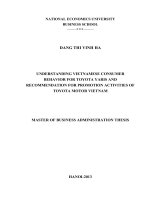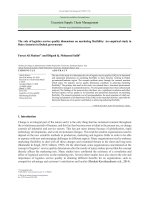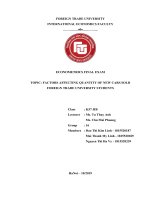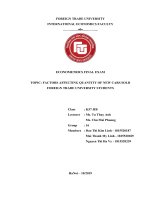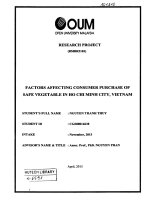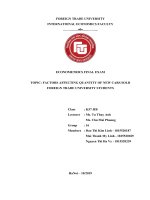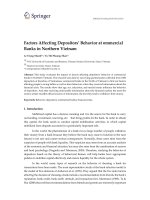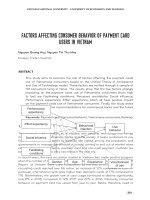final report factors affecting consumer behavior for pepsis carbonated soft drinks
Bạn đang xem bản rút gọn của tài liệu. Xem và tải ngay bản đầy đủ của tài liệu tại đây (5.85 MB, 48 trang )
<span class="text_page_counter">Trang 1</span><div class="page_container" data-page="1">
<b>TON DUC THANG UNIVERSITY FACULTY OF BUSINESS ADMINISTRATION </b>
<b>MAJOR: INTERNATIONAL BUSINESS </b>
<b>FINAL REPORT </b>
<b>TOPIC: FACTORS AFFECTING CONSUMER BEHAVIOR FOR PEPSI'S CARBONATED SOFT DRINKS</b>
<b> Lecturer: Le Thi Hong Minh </b>
Group: 5 shift 1 (Friday) 3Class: 19DF0701
<b>Ho Chi Minh City, 25th of December, 2021 </b>
</div><span class="text_page_counter">Trang 2</span><div class="page_container" data-page="2"><b>LIST OF GROUP MEMBERS </b>
<b>1 </b> Nguyen Thi Hong Ngoc 719D0105 Leader
</div><span class="text_page_counter">Trang 3</span><div class="page_container" data-page="3"><b>COMPLETION LEVEL EVALUATION TABLE </b>
<b>ID </b>
<b>Assignment of duties </b>
- Introduction - Conclusion - Prepare slide - Support
interview
- Chapter 1 (1.2) - Chap 2
(2.3.1) - Suport script
<b>3 </b> Nguyen Thi Hong Ngoc 719D0105
- Make interview, plan presentation - Chapter 2
(2.3.1) - Control all
conatct and support for all members
- Chapter 2 (2.1)
- Chapter 1 (1.1)
</div><span class="text_page_counter">Trang 4</span><div class="page_container" data-page="4">- Support script
- Chapter 1 (1.3) - Chapter 2
</div><span class="text_page_counter">Trang 5</span><div class="page_container" data-page="5"><b>ACKNOWLEDGEMENT </b>
The first thing we want to say on behalf of the entire group is that this subject is important; it has provided us with a general overview of the worldwide business field. This is a significant subject in university programs since it not only provides broad knowledge about the industry but also provides real data on business needs. We have gathered a lot of lessons, positive experiences, and skills from this subject over the last few months.
We'd want to thank PhD. Le Thi Hong Minh, who taught and shared vital knowledge and experiences with us over the course of the study. The professors' knowledge and fact-sharing stories will undoubtedly lay the groundwork for us to be successful in our future occupations.
However, preparing essay, report or presentations while researching will almost always result in errors. As a result, we expect that our professors and classmates would comment and assess more so that we can progress in other disciplines. Thank you for everything.
</div><span class="text_page_counter">Trang 7</span><div class="page_container" data-page="7"><b>INTRODUCTION ... 1 </b>
<b>CHAPTER 1: BRIEF OVERVIEW OF PEPSI BRAND... 3 </b>
<b>1.1 Introduction about PepsiCo and Suntory PepsiCo Vietnam Beverage ... 3 </b>
<b>1.2 History of formation and development ... 3 </b>
<b>1.2.1 History and development process of PepsiCo ... 3 </b>
<b>1.2.2 Suntory’s journey and the story that brought Pepsi to Vietnam ... 4 </b>
<b>1.3 Overview of carbonated soft drink product lines and the new zero-calorie Pepsi product line ... 5 </b>
<b>CHAPTER 2: AN EXAMINATION OF THE ELEMENTS INFLUENCING </b>CUSTOMER BEHAVIOR IN RELATION TO PEPSI’S CARBONATED SOFT <b>DRINKS ... 7 </b>
<b>2.1 An overview of the Vietnamese soft drink market ... 7 </b>
<b>2.2 Pepsi's primary customer segments ... 9 </b>
<b>2.3 Key theory application, data analysis, and consumer "insights"... 9 </b>
<b>2.3.1 Internal factors influence consumer behavior ... 10 </b>
<b>2.3.1.1 Perception ... 10 </b>
<b>2.3.1.2 Learning and memory ... 14 </b>
<b>2.3.1.3 Motivation and affect... 15 </b>
<b>2.3.1.4 The self: Mind, Gender, and Body ... 16 </b>
<b>2.3.1.5 Personality: Lifestyles, and values ... 18 </b>
<b>2.3.1.6 Attitudes and Persuasive Communications ... 20 </b>
<b>2.3.2 External factors influence consumer behavior ... 26 </b>
<b>2.3.2.1 Group Influences and Social Media ... 26 </b>
<b>2.3.2.2 Income and Social Class ... 28 </b>
<b>2.3.2.3 Cultures... 30 </b>
<b>CHAPTER 3: EVALUATE THE ANALYSIS RESULTS AND PROPOSE SOME NEW STRATEGIES FOR PEPSI IN THE NEXT 3-6 MONTHS ... 32 </b>
<b>3.1 A general evaluation of Pepsi's existing products and strategy... 32 </b>
<b>3.2 Proposing a new strategy for Pepsi in the next 3-6 months ... 35 </b>
<b>CONCLUSION ... 38 </b>
<b>REFERENCES... 39 </b>
</div><span class="text_page_counter">Trang 8</span><div class="page_container" data-page="8"><b>LIST OF TABLE</b>
<b>Table 1 Perception ... 13 </b>
<b>Table 2 Learning and memory ... 15 </b>
<b>Table 3 Motivation and affect ... 16 </b>
<b>Table 4 The self: Mind, Gender, and Body ... 18 </b>
<b>Table 5 Personality: Lifestyles, and values ... 19 </b>
<b>Table 6 Attitudes and Persuasive Communications ... 21 </b>
<b>Table 7 "Live for Now" advertisement... 25 </b>
<b>Table 8 Group Influences and Social Media ... 27 </b>
<b>Table 9 Income and Social Class ... 29 </b>
<b>Table 10 Cultures ... 31 </b>
</div><span class="text_page_counter">Trang 9</span><div class="page_container" data-page="9"><b>LIST OF PICTURE </b>
<b>Picture 1. Pepsi Brand ... 2 </b>
<b>Picture 2. The logo of Pepsi over years ... 3 </b>
<b>Picture 3. Revenue of key beverage brands in Vietnam from 2016 to 2019 ... 8 </b>
<b>Picture 4. Tiki x Ha Anh Tuan Singer ... 32 </b>
<b>Picture 5. Pepsi in "gen Z" ... 33 </b>
<b>Picture 6. The drama of Pepsi... 34 </b>
<b>Picture 7</b>. Pepsi "ngõ nhỏ"<b> ... 35</b>
<b>Picture 8. Pepsi x Nguyen Thuc Thuy Tien ... 37 </b>
</div><span class="text_page_counter">Trang 10</span><div class="page_container" data-page="10"><b>INTRODUCTION </b>
Customer behavior is a subject that specializes in the study of psychological as well as external objective elements that influence consumers' purchase decisions, thereby assisting them in selecting items that are appropriate for their needs. This is also regarded as a relationship between environmental stimuli and human cognition and behavior. In other words, customer behavior encompasses people's thoughts and feelings during the consumption process, as well as the activities they take to eventually conduct a certain behavior, such as purchasing decisions, utilizing or disposing of specific products or services.
With the outstanding development of the economy today, inter-country cooperation is steadily becoming more common, generating both opportunities and obstacles. Faced with this circumstance, multinational firms' collaboration with local enterprises has assisted developing countries like Vietnam in learning from experience, boosting their qualifications in various fields and areas, and making it easier for consumers to access international brands. For example, in the sphere of F&B, a slew of foreign brands such as McDonald's, Subway, Pizza Hut, Coca Cola, Pepsi, and others have recently arrived in Vietnam. Especially Pepsi, which has now become recognizable to people all over the world, including Vietnam, this brand is increasingly expanding its scope of activities globally and steadily building its place in the hearts of customers.
When we think of Pepsi, we think of a brand from a multinational firm that is popular among young people and Vietnamese. They not only provide a large choice of products at low costs, but they also continually update new trends, such as environmentally friendly packaging and products for clients who lead a healthy lifestyle. It is partly because of this allure that we chose the topic "Factors Affecting Consumer Behavior Toward Pepsi's Carbonated Products" to provide an outline of the key to their success. Furthermore, we want to understand more about the Pepsi brand, consumer psychology of carbonated soft drinks, and then we will suggest some Pepsi's new development strategy for the next 3-6 months.
The report is divided into three main chapters: Chapter 1: Brief overview of Pepsi brand
In this chapter, we will provide an overview of PepsiCo Corporation and Suntory PepsiCo Vietnam Beverage Corporation. From there, we will have a general understanding of the history of the birth and the story that introduced Pepsi to Vietnam.
Chapter 2: An examination of the elements influencing customer behavior in relation to Pepsi’s carbonated soft drinks
</div><span class="text_page_counter">Trang 11</span><div class="page_container" data-page="11">This is the most essential chapter; our team offered an overview of the soft drink market in Vietnam, the main Pepsi customer segments, then chose a few theories and investigated them in-depth elements influencing consumer behavior of Pepsi products through interviews.
Chapter 3: Proposed some new strategies for Pepsi in the next 3-6 months
In this section, our team provides general remarks on customer behavior from each interview in order to identify solutions to overcome or recommend new initiatives for Pepsi in the next 3-6 months.
Picture 1. Pepsi Brand
Source:
</div><span class="text_page_counter">Trang 12</span><div class="page_container" data-page="12"><b>CHAPTER 1: BRIEF OVERVIEW OF PEPSI BRAND </b>
<b>1.1 Introduction about PepsiCo and Suntory PepsiCo Vietnam Beverage </b>
PepsiCo is a worldwide fast-moving food and beverage (FMCG) corporation with operations in over 200 countries, with the most prominent product being carbonated soft drinks, which were invented by a pharmacist named Celeb Bradham near North Carolina. The company, originally known as "Pepsi-Cola," was founded in 1898 and is headquartered in Buy City, New York. Suntory PepsiCo Vietnam (SPVB) was founded in April 2013 with 100% foreign investment. It is a joint venture between Suntory Group
<b>(Japan) and PepsiCo (USA). </b>
After many years of being officially present in Vietnam, the company has established a leading position in the beverage market, and they are always proud to be a part of the lives of all customers, as well as being influenced in various ways, particularly among young people. Suntory PepsiCo Vietnam aspires to not only earn large sums of money for businesses each year, but also to provide consumers with high-quality beverage goods and to become an environmentally conscious brand. These are also aspects that have contributed to PepsiCo's worldwide success, giving long-term benefits to society and shareholders; it is because of these long-term development goals that PepsiCo has become one of Vietnam's most prestigious brands in recent years.
Below is the contact information and logo of Suntory PepsiCo Vietnam: • The head office is located on the 5th floor of Sheraton Hotel (88 Dong Khoi
Street, District 1, Ho Chi Minh City, Vietnam). • Phone: (84 28) 3 821 9437
• Fax: (84 28) 3 821 9436
Picture 2. The logo of Pepsi over years
<b>1.2 History of formation and development </b>
<b>1.2.1 History and development process of PepsiCo </b>
A pharmacist named Bradham, born in 1867 in Chinquapin, Dublin County, North Carolina created an easy-to-digest drink called "Brad Drink" in 1886 using sugar,
</div><span class="text_page_counter">Trang 13</span><div class="page_container" data-page="13">vanilla, carbonate water, and cola nuts. He began testing and selling this water in his neighborhood. Bradham was about to grow his firm in 1898, so he renamed the drink "Pepsi-Cola" and gave it the logo title.
Bradham officially registered a trademark with the United States Patent Office and founded the Pepsi corporation in 1902, with its headquarters in Purchase, New York state, USA. Advertisements for Pepsi-Cola began to appear in New Bern's weekly magazine. From there, Pepsi-Cola grew in popularity, the company expanded, and Bradham began purchasing buildings to convert into factories for the beverage.
During World War I, the Pepsi-Cola Company declared bankruptcy and was purchased for $30,000 by Craven Holding Corporation of North Carolina. Roy C. Megargel later purchased the Pepsi brand from Craven Holding Corporation for $35,000 and renamed it Pepsi-Cola Corporation. Pepsi-Cola Corporation declared bankruptcy for the second time in 1931, after years of losses. Chairman of Loft Industries Charles Guth purchased Pepsi-Cola and began selling it in his stores. The following are a few historical milestones associated with this brand that we can recall:
• 1934: Pepsi-Cola skyrocketed sales in the US market
• 1935: Pepsi-Cola moves its headquarters to Long Island City, New York • 1941: Expanding to the whole of Europe
• 1947: Penetrating to the Philippines and the Middle East • 1948: Headquarters moved to downtown Manhattan. • 1965: Frito-Lay Corporation was acquired by Pepsi-Cola
• 1988: Pepsico acquired Tropicana and celebrated its 100th anniversary and changed to a new logo with a sphere with 3 colors blue, white, red on a cold blue background this is also the worldwide Pepsi logo. 3
PepsiCo is presently the world's largest and fastest-growing food and beverage corporation, with over 200 locations worldwide and annual sales of around $60 billion.
<b>1.2.2 Suntory’s journey and the story that brought Pepsi to Vietnam </b>
Suntory Holdings Limited and PepsiCo, Inc. launched the strategic beverage alliance Suntory PepsiCo Vietnam in 2013 to deliver worldwide standard products to Vietnamese customers. SPVB's value standard is to "sell only products that we are proud of " and it is because of this commitment that the company has grown to become one of Vietnam's largest beverage companies. Here are some important dates to remember:
• 12/12/1991: Sp.Co and Marcondary - Singapore entered into a joint venture and established the International Beverage Company (IBC).
• 1992: Hoc Mon Factory was built.
</div><span class="text_page_counter">Trang 14</span><div class="page_container" data-page="14">• 1994: Vietnam lifts embargo from the US. PepsiCo immediately entered into a joint venture with the International Beverage Company (IBC) and officially entered the Vietnamese market with the first two products Pepsi and 7up. • 2003: International Beverage Company (IBC) completed the change of capital
structure with 100% ownership owned by PepsiCo and was renamed PepsiCo Vietnam International Beverage Company. At the same time, launching many other beverage products such as: Lipton Ice Tea, Twister, Sting, Aquafina. • 2004: Expanding production and business model in Quang Nam by purchasing
and merging Dien Ban factory.
• 2005: Become the leading beverage company in Vietnam.
• 2006: Snack Poca - the first Food product launched by PepsiCo Vietnam and loved by many consumers.
• 2007: Soy milk product was launched.
• 2010: PepsiCo continues to invest for the next three years in Vietnam with 250 million USD and operates the factory in Can Tho. Has been considered an important milestone for PepsiCo in the Vietnam market.
• 2012: PepsiCo continued to buy a factory in Dong Nai and PepsiCo became the company with the largest factory in Southeast Asia located in Bac Ninh. • 2013: Suntory Holdings Limited and PepsiCo, Inc. cooperated to establish
Suntory PepsiCo Vietnam and launched new products, Olong Tea+ Plus and Mountain Dew.
<b>1.3 Overview of carbonated soft drink product lines and the new zero-calorie Pepsi product line </b>
PepsiCo is a multinational corporation that controls the majority of the beverage market in Vietnam. Carbonated beverages are one of the segments that the corporation, as well as young consumers, pay close attention to. Pepsi-Cola, a long-standing but very modern and outstanding carbonated product line with a combination of brands and well-known music groups, is the fastest-selling product line on the market. 7Up Revive, a mineral-replenishing beverage when exhausted, is followed by 7Up, a carbonated beverage with a natural lemon flavor that provides you a cool and pleasant feeling. Mirinda, a strong carbonated drink that provides the drinker an explosive feeling, comes in third place, followed by Mountain Dew, a carbonated beverage with a strong citrus flavor that offers the drinker a feeling of refreshment and exhilaration.Almost all of Pepsi's carbonated water products have their own distinct characteristics, which is one of the reasons Pepsi has a bigger market share in our country than rival Coca-Cola.
The most well-known product line in the carbonated beverage market is Pepsi Cola. This company has recently launched a zero-calorie Pepsi product line, which is unlike anything else on the market at the time. They recently invented a new flavor for it, Pepsi Zero Calorie Lemon. Overall, this is a highly distinctive product, from the box
</div><span class="text_page_counter">Trang 15</span><div class="page_container" data-page="15">design to the taste within. With a combination of cool lemon taste and refreshing gas, the zero-calorie lemon-flavored Pepsi is put on a striking and personal matte black shirt, the color changes from traditional blue to black, and this product also contains no calories, making it very suitable for people who care about their health. This product line was created since today's customers are increasingly concerned about their personal health and try to avoid using dangerous items. Pepsi has investigated and developed a sweet beverage product including aspartame and sucralose, two highly low-calorie sweeteners that allow you to effortlessly control the quantity of sugar and calories absorbed into your body. Pepsi thinks that by introducing this product line, it will be able to meet the needs of customers and dispel the myth that drinking soft drinks increases the risk of cardiovascular disease and osteoporosis due to the presence of phosphoric acid and high levels of phosphate.
</div><span class="text_page_counter">Trang 16</span><div class="page_container" data-page="16"><b>CHAPTER 2: AN EXAMINATION OF THE ELEMENTS INFLUENCING </b>
CUSTOMER BEHAVIOR IN RELATION TO PEPSI’S CARBONATED SOFT
<b>DRINKS2.1 An overview of the Vietnamese soft drink market </b>
In recent years, the beverage sector in Vietnam has been on a strong trend, with many enterprises owning a variety of soft drinks ranging from mineral water to teas and, in particular, soft drinks. Vietnam ranked 24th in the world in terms of US beverage consumption in 2020, with revenue of more than $5 billion USD, a 1.7% decrease from 2019. The beverage industry in Vietnam currently has a The drive gauges the country's development speed, favorable demographics, and the rapid development of the foodservice industry considerably enhance customer demand. Furthermore, Vietnam has a young population, with the age group 15-54 years old accounting for more than 62.2%; this age group is highly valued for its beverage consumption demand.
Furthermore, carbonated soft drinks account for 23.74 percent of the beverage market share in Vietnam. This industrial expansion is now being led by two multinational competitors, Coca-Cola and PepsiCo, which dominate the market with a 64 percent market share, followed by two domestic competitors, Tan Hiep Phat and Trung Nguyen. Original. There are over 2000 indigenous and foreign beverage production plants in Vietnam. The rise of this industry is particularly visible from 2015 to the current year, with an annual growth rate of 6%. The graph below depicts the sales of major beverage brands in Vietnam from 2016 to 2019. We can see from the graph that:
</div><span class="text_page_counter">Trang 17</span><div class="page_container" data-page="17">Picture 3. Revenue of key beverage brands in Vietnam from 2016 to 2019 Source: The Suntory PepsiCo joint venture earned more than VND 18,300 billion in 2019, an increase of more than 14 percent over 2018. PepsiCo outperformed with a market share that was more than double that of Coca-Cola and Tan Hiep Phat. In April 2013, PepsiCo and Suntory formed a joint venture, which helped this company's product line outperform. Pepsi has had to constantly adapt and update new product lines in step with customer trends, as well as have vital marketing tactics, to be successful as today is a long process. Suntory PepsiCo, a joint venture between PepsiCo of the United States and Suntory Holdings Ltd of Japan, led the market with revenue of VND 18.3 trillion ($793 million), up 14 percent year on year, followed by Coca-Cola with 9.3 trillion VND.
The future growth rate of Vietnam's beverage market is highly regarded. Companies will struggle to cope with increased competition if they do not find ways to innovate and diversify their products in the future. This is the time when communication methods will blossom in order to entice customers to use their products. As a result, understanding the market's shortcomings and strengths is critical for developing an effective campaign for your company. The year-end market of Vietnam's beverage sector has never stopped being hot; this is both an opportunity and a difficulty for those who wish to enter this industry.
</div><span class="text_page_counter">Trang 18</span><div class="page_container" data-page="18"><b>2.2 Pepsi's primary customer segments </b>
Since entering the Vietnamese market - a country with more than half of the population being young people, Pepsi-Cola has determined its mission lies in this class - the age that is always devoted to passion; they love sports and are especially proud of the national football team. In addition, they also like to discover new things, like to experience themselves and this is a favorable condition for Pepsi-Cola to approach and develop in Vietnam.
When choosing a vibrant customer base, Pepsi has favored its products with the qualities (from flavors to marketing methods) necessary to create an impressive moment that goes deep into the hearts of customers. With a rich sweetness and a large amount of gas, Pepsi-Cola gives consumers a new feeling - a strong taste that is felt to the tip of the nose like burning enthusiasm, bringing refreshing and new sensations. And it is this that has met the psychological preference of most teenagers. Besides, young people often have the habit of sipping food and enjoying drinks at the same time so that they don't feel bored when enjoying food, and this is a feature that Pepsi-Cola focuses on exploiting to create products that meet this need of young consumers.
In the Vietnamese market, Pepsi has become a big player in the carbonated drink industry, but its attraction has always remained in the hearts of young consumers to this day. In Vietnam, it can be said that the style feature that Pepsi is pursuing is to satisfy the passion of young people. Therefore, the price of the products as well as the design or quality offered by Pepsi are aimed at the needs of young people.
Currently, more than half of Vietnam's population is under the age of 30, which is enough to prove that young people are an extremely potential market segment for businesses. Pepsi seized this segment to launch the zero-calorie Pepsi and was extremely successful when it was accepted by young people.
<b>2.3 Key theory application, data analysis, and consumer "insights" </b>
This is the most crucial section of this research. In this part, we will use the theories we have studied, then conduct interviews with Pepsi consumers from which we may draw general conclusions for each content, and finally provide assessments and detailed ideas for the PepsiCo corporation to enhance even further. The basis of this research is that we can clearly grasp customer psychology, both internally and outside, in order to develop appropriate marketing tactics. We will separate the evaluation and recommendations in chapter 3, this part just focuses solely on data analysis,
In terms of the interview form, we performed an online interview through Google Meet, however, in order to make the results more complete and relatively accurate, we also sent the survey form to the customer in parallel. As a result, throughout the study, our results include both customer opinions and conclusions expressed in percentages.
</div><span class="text_page_counter">Trang 19</span><div class="page_container" data-page="19"><b>2.3.1 Internal factors influence consumer behavior </b>
In this part, we examine internal elements to understand how they influence consumer behavior. This is a difficult aspect because it is all about the customer's psychology, thoughts, and attitudes. However, by attentively following the theories provided, we have identified their inner world quite effectively. The detailed analysis results are as follows:
<b>2.3.1.1 Perception</b>
In this first chapter, our group chose the process of adoption, Sensony Marketing through consumer senses as the main theoretical basis. The process of receiving is one of three information processing steps - the set of activities generated by external stimuli that have been converted into information and stored into human memory or perception. By showing their interviewers the posters, the label's commercials, and asking them firsthand about their own experience of buying and using calorie Pepsi, we've been given a lot of answers that say:
<b>1. How do you feel about the packaging design and the product </b>
<b>line's signature black color? </b>
<b>2. How do you feel about the printed ads or billboards for this zero-</b>
<b>calorie product line near the bus </b>
<b>stop? </b>
<b>3. When you look at that poster/short advertisement, </b>
<b>can you envision and </b>
<b>hear any sound? </b>
<b>4. Have you ever purchased </b>
<b>a drink to check it out? If so, </b>
<b>how did you find the taste? </b>
<b>5. How do you feel when you </b>
<b>touch a calorie-free Pepsi </b>
<b>can, and how does it differ from </b>
<b>the standard </b>
<b>lines? </b>
Lê D°¡ng Thị Thanh Thanh
Strangely, the package was rough before it was smooth. I believe it's fairly similar to simply adding the words "no calories." I was drawn to the hue.
A good phrase that captures the trend, such as "Pepsi lemon flavor without calories, optimum refreshment, burst with
The sound of the bottle cap popping and the smell of it.
The lemon flavor is pretty distinctive.
The dimensions have not been altered.
</div><span class="text_page_counter">Trang 20</span><div class="page_container" data-page="20">Nguyễn Mai Linh
Stunning, catching Very pleasant, and visually stunning. In terms of color, I thought it rather impressive because, in general, it was the first time I saw a beverage product in such a dark shade of black.
eye-The advertisement is highly appealing and full of significance.
Summer music, the holiday season
The smell isn't too bad, and it's easy to drink.
Textured designs are more comfortable to hold than smooth designs.
Huỳnh Thị Thanh Hoài
The hue of the lemon calorie-free Pepsi is black with a hint of lemon green, which impresses me and makes it easy to recall.
Images that are vivid and have catchy slogans
In the summer, enjoy the coolness.
This product line has a very nice lemon flavor, so when I drink it, I feel interested, and even if I drink a lot, I don't get bored.
In the same way that any other soft drink product
Lê T°ờng Vy
In terms of packaging, I believe it maintains the prior items' brand character.
The colors on the poster are stunning.
Pretty bright and lovely, highly appealing to the eye
In terms of taste, I believe that a Pepsi product without calories has a more lemon flavor and that it has more gas, making it more
It's not too picky, and it's convenient for everyone.
</div><span class="text_page_counter">Trang 21</span><div class="page_container" data-page="21">comfortable to drink than other Pepsi products.
TrÃn Lê Thịnh
The main color tone is black rather than blue, which is a distinguishing feature. The combination of black and green has a lemon flavor. Pepsi and its collaboration with Blackpink will have a pink tint to provide a distinctive highlight, whilst other brands will not.
It's very cool in my opinion.
What could be more delightful than the sound of cool ice coupled with sweltering summer?
I got it to give it a try; it's not too sweet.
All clients will find it very convenient.
Lê Liên Long
I see the Pepsi logo without calories, it is similar to the logo of other Pepsi products but the problem is the color of that Pepsi can, it enhances the Pepsi logo.
In my own opinion, it's as normal as any other social class
Feel the extreme coolness
In terms of taste, I prefer it over ordinary Pepsi.
The same as prior goods
Phan Thành Long
Its logo is similar to the logo of other Pepsi products, but the problem is that the color of that Pepsi
Not too prominent for myself
Maybe it's refreshing
Lighter than normal
Right size, neat
</div><span class="text_page_counter">Trang 22</span><div class="page_container" data-page="22">can enhance the Pepsi logo.
Hồ Thị Thùy D°¡ng
Concerning the logo of the zero-calorie Pepsi product, I notice that it is spherical in shape and has three colors that appear quite current and elegant. In terms of color, matte black makes me feel more opulent.
It seems normal to me.
Experience its flavor
The taste of zero-calorie Pepsi is sweeter than that of other products.
It's most likely dropped thicker than other products.
TrÃn Khã Nhi
Concerning the logo, I believe it remains the same; the color is black, the style is cool and bold.
Make the city come alive
When it's hot outside, nothing beats a cold can of Pepsi.
The taste of zero-calorie Pepsi is sweeter than that of other products.
Really convenient
Table 1 Perception
** Regarding the packaging and design, the interviewers stated that: ●<small> </small>The design is quite beautiful and eye-catching
●<small> </small>Black and blue colors are very attractive and visually appealing
●<small> </small>Looks strange, the rough packaging is easier to hold than the plain packaging even though the size has not changed
●<small> </small>Good and trending slogan
● The ads are fun because the bottle cap is popped and brings a lively atmosphere as well as the sound of summer and festive season.
** In terms of taste, most of them feel that: ●<small> </small>It's more deliciously
●<small> </small>Lighter than normal Pepsi ●<small> </small>The lemon flavor is quite unique
●<small> </small>The taste is not too unpleasant and quite easy to drink
</div><span class="text_page_counter">Trang 23</span><div class="page_container" data-page="23">** Regarding the product display area, they noticed:
●<small> </small>The shopping space for Pepsi products is attractive because of its central location ●<small> </small>Products placed at eye level will attract them more than high or low areas.
We may conclude that Sensory Marketing is critical since it seeks to develop an emotional link between consumers and products, services, or brands. Marketing involves interacting with clients' emotions, but approaching them through their five senses involves directly accessing their emotions. The qualities, attributes, or even the arrangement in the sales area that touch the five senses of customers will encourage them to buy more.
<b>2.3.1.2 Learning and memory </b>
Second, Learning and Memory, by showing our customers a Pepsi ads campaign called "Nothing Gets your way Home," we applied the classic condition theory - behavior is a result of creating conditional reflexes, which is the continuous growth and repeated link to see how it affects them.
<b>6. Usually, which position will attract you more about Pepsi </b>
For me, face-to-face is probably more accessible no matter what product it is
I think yes because I am also a fan of Pepsi products
Lê T°ờng Vy Looking down from above <sup>If the call is </sup><sup>attractive</sup><sup>, the Pepsi brand </sup>will attract me to buy more
TrÃn Lê
Thịnh <sup>In my opinion, it's from </sup>right <sup>left to </sup>
I think the display and shopping space are not very impressive to me Lê Liên Long Maybe when I face it
I mean maybe yes, because the large space will create a comfortable feeling when shopping
Phan Thành
Long <sup>Central of area </sup> <sup>Small space, not right in the center </sup>
</div><span class="text_page_counter">Trang 24</span><div class="page_container" data-page="24">TrÃn Khã Nhi <sup>I think it's in a </sup><sup>supermarket </sup><sup>or a </sup>place with a lot of people
I mean no, because I just go in and buy my favorite products and don't care about the shopping spaceTable 2 Learning and memory
Now the result that we noticed was that they were typically too uncomfortable to watch an ad too much, but on the positive side, they were actually interested to see the commercial, because a lot of the rappers who came along, and that Pepsi had the slick, humanist and meaningful message. Apart from that, we could see that everything that was difficult after we drank Pepsi could be done in this commercial, but this accidentally this detail did something positive and real for the viewers, and it also applies to Truth Effect - the content that we've learned about.
So one can see that the advertising messages are concise, understandable, compelling and that if they are still repeated, again and again, they will automatically enter consumer awareness and memory.
<b>2.3.1.3 Motivation and affect</b>
In this area, my group is interested in Maslow's hierarchy of requirements and Drive Theory, which explains the biological state of the body when it lacks something it needs to survive. Based on the findings of the interviews, we determined that Pepsi products met two demands of consumers: the biological need for refreshments and the safety need for a product. In this scenario, weight reduction is considered harmless or good to the body.
<b>1. How do you feel after watching this ad </b>
<b>2. Do you often get annoyed when you see the same ad too </b>
<b>many times?</b>
<b>3. Do you think every problem after </b>
<b>drinking Pepsi has a solution like in </b>
<b>this ad?</b>
Lê D°¡ng Thị Thanh Thanh
Good, Interesting because there are many rappers participating
Lê T°ờng
Depence on each situation
</div>
